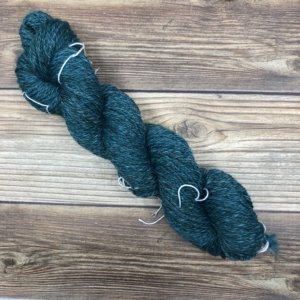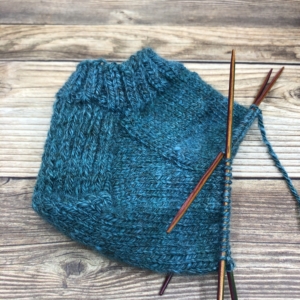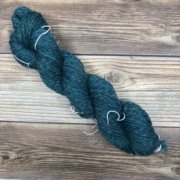Review: Spinning for Socks online course
reviewed by Karen Robinson
I love knitting socks, but I had never knit socks using handspun yarn. Even though I was inspired by the Sock issue of PLY (Winter 2018), I still hadn’t sat down and actually tried any of the techniques given in that issue. So I was really excited to take this online course from Alanna Wilcox on Spinning for Socks.
Upon purchase of the course, I received a PDF with a link to the course and a unique password. The course contains two hours of pre-recorded videos that you can watch on your own schedule as many times as you’d like. (You can schedule individual one-on-one lessons with Alanna after taking the class if you need/want more in-depth lessons.) There are also 3 worksheets provided as part of the course: an overview of the videos, a chart of wool grades and micron counts, and a twist gauge tool.
On the course website, the list of prior knowledge makes it clear what you need to know to be successful in this course. Essentially, it’s suitable for spinners with a basic knowledge of spinning. A list of materials is also provided, although it is recommended to watch all of the videos first before purchasing any items to be sure you don’t buy anything you personally wouldn’t find beneficial.
The videos include an introduction plus 4 videos, with a time stamp list of contents for each video so you can jump to a specific topic. This is very handy for when you want to go back and watch part of a video again. Videos are between 21 and 35 minutes long.
The intro video gives a brief overview of the workshop, why you’d want to use handspun for socks, and suggestions for how to go through the workshop. The course videos cover spinning from already prepared fiber as well as spinning from fleece. Alanna does a good job outlining at the beginning of each video what will be covered in the video. Each video contains some lecture, some demonstration, and some slides with images. Overall the presentation is clear and organized.
Video breakdown
The first video gives a good overview of the considerations to keep in mind when planning for spinning and knitting socks (desirable sock qualities). An advanced spinner would probably be familiar with this information already, but the video is still worthwhile watching for little tidbits here and there. For someone less familiar with this information, you’ll get a solid foundation.
One small issue I noticed is that when you finish a video (which is hosted on Vimeo), another video from Alanna’s channel comes up (not related to this course). Although it doesn’t autoplay, it does replace the course video on the website you are viewing, so if you want to get back to the course video, you need to refresh the page.
The second video looks specifically at the best wool for socks as well as possible blends. Alanna shows example of carding and pulling through a diz and gives options for what to do if you don’t have hand cards. (You can also use commercial top.) There’s a short quiz toward the end of the video giving 3 options for you to choose which blend would be best for socks, which is nice to test the knowledge you’ve learned in this lesson.
The third lesson is divided into 2 videos. The first one starts with a lesson on worsted spinning and uses short backward draw. At one point in the video, the sound quality isn’t quite as good (it seems like some minor feedback); if you’re listening with earbuds, you should watch for this about 5 minutes in because it might be jarring to your ears (it lasts about 5 minutes). Alanna does a worsted vs woolen comparison (which is a little repetitive because it was also done in the first video but it’s more in depth and can be good to reinforce the knowledge, especially if it’s new to you). She shows how to measure twist angle and then gives a challenge for you to try out measuring twist. (I found this to be a really helpful part of the course.) She also shows how to use plyback samples to figure out the best twist and WPI to use. (Note: the camera had some autofocus issues during this part.)
In part 2 of the third lesson, Alanna shows you how to deconstruct commercial sock yarn to find twists per inch of both plied yarn and the singles and then shows how to spin to match that commercial sock yarn. The focus here is on how much twist to add in both the single and the plied yarn. She discusses the number of plies best appropriate for sock yarn; however, she does not mention other options such as cable, crepe, or opposing ply yarn. She also talks a bit about fiber prep and wheel setup. The challenge for this lesson is to spin a specific WPI and twist angle yarn using a fiber recommended.
There are some great examples of pretty handspun socks (credit given to the spinners/knitters at the end of the last video). If you like cats, make sure to watch to the very end.
The verdict
If you’re new to sock spinning (or have tried sock spinning but haven’t felt successful) and want a good foundation for where to start, this video course will definitely be helpful to you. If you’ve done some spinning for socks using 3-ply and 4-ply yarns that you’re happy with and want to expand your skills beyond those yarn constructions, you won’t find that in this particular video course, though you may find some tips sprinkled throughout that you would find helpful.
My sock spinning experience so far

As for myself, I started with some BFL fiber and spun some samples to put on a card to help keep me consistent as I spun. I feel like I did great with regard to the twist angle and twists per inch; however, I was so focused on that part that I didn’t pay as close attention to my WPI. So when I finished my 3-ply yarn, I realized that it was more of a sport weight than the fingering weight yarn I had been aiming for.

I did start knitting a sock with it, but I used my usual size needles for fingering weight yarn and realized that was making my hands hurt. So I haven’t finished the first sock yet (and I even made it an ankle sock) as the knitting is slow going. But I did spin only half of the fiber, so with the other half, I’m trying again, this time trying to focus as much on the thickness of the yarn as I did on the twist. I’m still working on this project but so far I’m already noticing a difference and feel hopeful that this attempt will produce something much closer to the fingering weight yarn I am aiming for.
PLY Magazine believes that Black lives matter, as well as LBGTQI+ lives. Those most vulnerable and persecuted in our communities deserve our love and support. Please be good to each other.





Leave a Reply
Want to join the discussion?Feel free to contribute!